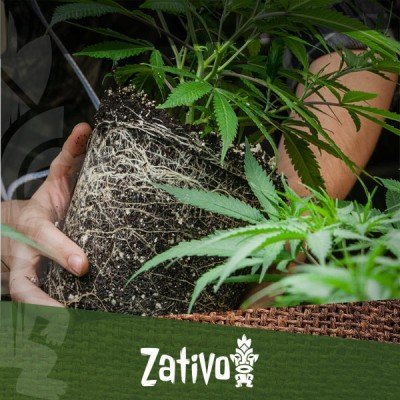Don't have an account?
Register NowYou have to add to cart at least 5 bottles or any program to make checkout.
- BlogWhat is the best time to transplant your cannabis plants?
What is the best time to transplant your cannabis plants?
Published: June 15th, 2016
Categories:
Cannabis Cultivation
When growing in pots either organically or in a soilless medium, transplanting your plants into bigger pots is essential if you wish to grow big plants and expect bigger yields. The key times to transplant is what really makes the difference in a vigorous thirsty plant and a plant who has not even filled the pots with roots. Most people think that if you place a clone or seedling into a huge pot, the plant will grow into the pot and grow huge. This is true to a degree but the most important thing to remember is ‘ Big Roots = Big Shoots. ‘
With this in mind, the objective is to grow big fluffy bright white roots that will grow bigger and settle into a new pot or medium. When plants are small, aim at growing in small pots to begin with a 2 litre size and look to finish in a 15 litre pot. Once the plants are growing and at the 4th leaf set, check the roots by turning the pots upside down whilst grasping the plants stem between your fingers. Check the roots are totally covering the medium. The roots should look bright white with fish bone characteristics. Roots can also look hairy and sometimes furry and will often overlap one another. The reason you should transport at this point is because the plants is ready to be placed into a 6.5 Litre sized pot for example and left to vegetate further. By this stage the plant will be growing well and upto its 7th leaf set. Many growers may have a final medium in mind for the flowering stage that is rich in Phosphorus and Potassium. By growing the plants out until the roots are the same as in the 2 Litre pot, the plants will grow bigger as the roots reach for new nutrients.
What if the roots have not filled the pot?
The reason why the roots of a plant or even a tree push down and out into the Earth, is because they are simply searching for nutrients. There is a fine balance between the plant having a ready supply of nutrients available and the roots forced to reach out and search for new nutrients. If you have a healthy happy plant that is not near the point of thick roots overlapping one another, deep into the corners of the pots, then you can leave the plant for longer. Many growers who grow with soil and soilless medium, often add perlite as it is airy and inert. Advantages of perlite are the soil has more air retention and more pockets for the plant roots to grow into. Also perlite can dry a medium out quickly also allowing for a quicker rate of feeding. If you also notice that your roots are a dark brown colour or not a bright clean white, you can use hydrogen peroxide to sterilize the root zone by feeding with additional Oxygen in the water. As Long as the roots are sterile and clean, any pathogens will be killed and you can begin to focus on the plant growth again. This will kill off the microbial life you may of had from the soil or any additional bacteria that may have been added, however you can simply reintroduce the microbial life back in once roots are clear white again
Final Transplant During Flowering:
It is considered a good idea if growing organically to have a medium designed for the blooming phase. In addition to the nutrients available at the grow shop, the grower can add bat guano, hummus, ash, bacteria and even compost that has been breaking down over the time of the growing period if outdoors for example. So you may have a 15 litre pot with a heavy feed of Phosphorus and Potassium for the next 8 - 12 weeks of flowering.
Extra Drainage:
Roots benefit from oxygen in the medium as much as they do water, so it is recommended to add certain medium to aid drainage. A good idea is to add an inch high layer of hydroton clay balls whatever the pot size. Once you notice the plants roots are really pushing for nutrients and are beginning to look rootbound, select the final size pot you will use. It is also a good tip to consider that during the blooming phase, root growth will begin to slow down and eventually stop as the plant now focus its energy on flower production. When transplanting the final stage, make sure the medium is airy and light. This will allow for better water retention and can allow for dry periods if required.





